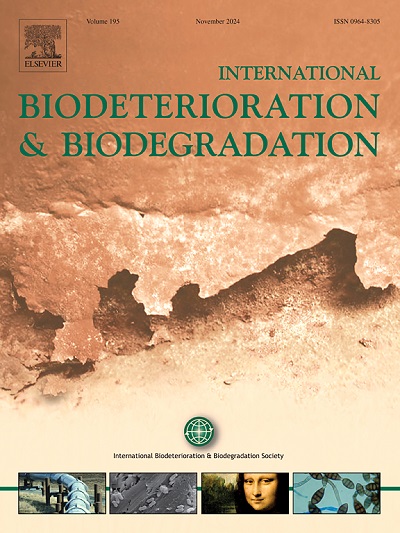Unveiling fungal degradation pathways for polyurethane and polyethylene through enrichment cultures and metabolic analysis
IF 4.1
2区 环境科学与生态学
Q2 BIOTECHNOLOGY & APPLIED MICROBIOLOGY
International Biodeterioration & Biodegradation
Pub Date : 2025-04-19
DOI:10.1016/j.ibiod.2025.106097
引用次数: 0
Abstract
The increasing accumulation of plastics in the environment poses significant threats to marine and terrestrial ecosystems. However, recent research highlights the potential of Lasiodiplodia iranensis, a tropical ascomycete fungus, to degrade synthetic plastics. The intrinsic molecular mechanisms and metabolic responses during the interaction and hydrolysis of plastics, particularly for polyurethane (PU) and polyethylene (PE), remain largely unexplored. This study was conducted to investigate its degradation activity and metabolic responses to PU and PE and showed L. iranensis could colonise and significantly degrade PU (11.05 % weight loss), showcasing its impressive capabilities but having minimal effect on commercial PE (0.53 %) in 60 days. Metabolomic analysis identified 51 and 63 differentially expressed metabolites in response to PU and PE, respectively, with 30 common metabolites. Pathways for enzyme production, metal ion chelation, nutrient uptake, and Krebs cycle intermediates were activated in the fungus exposed to PU, likely contributing to its enhanced hydrolysis of PU. In contrast, pathways for stress response, antioxidant activity, signal transduction, and membrane integrity were predominant for PE, likely due to its limited degradability. Increased metabolism of compounds like 2-oxoarginine, proline, L-valine and 1-methyl histidine, which serve as carbon and nitrogen sources, osmoprotectants, and derivatives for fungal enzymes were observed in both treatments, thus supporting nutrient and enzyme synthesis. Hydrolytic and oxidative enzymes, mainly esterase, lipase, cutinase, laccase, and peroxidase, were implicated in PU and PE biodegradation, with PU showing more robust degradation potential. This study provides useful insights into the metabolic pathways that facilitate plastic degradation in L. iranensis, identifying potential fungal metabolites and enzymes that could be harnessed for bioremediation efforts, thereby advancing the development of fungal-based solutions for plastic waste reduction.

通过富集培养和代谢分析揭示聚氨酯和聚乙烯的真菌降解途径
环境中塑料的日益积累对海洋和陆地生态系统构成了重大威胁。然而,最近的研究强调了一种热带子囊菌真菌Lasiodiplodia iranensis降解合成塑料的潜力。在塑料,特别是聚氨酯(PU)和聚乙烯(PE)的相互作用和水解过程中,内在的分子机制和代谢反应在很大程度上仍未被探索。研究结果表明,L. iranensis可以定殖并显著降解PU(失重11.05%),但在60天内对商用PE的影响很小(0.53%)。代谢组学分析分别鉴定出51种和63种对PU和PE有差异表达的代谢物,其中30种是共同代谢物。在暴露于PU的真菌中,酶生产、金属离子螯合、营养吸收和克雷布斯循环中间体的途径被激活,可能有助于其增强PU的水解。相比之下,应激反应、抗氧化活性、信号转导和膜完整性的途径在PE中占主导地位,这可能是由于其有限的可降解性。2-氧精氨酸、脯氨酸、l -缬氨酸和1-甲基组氨酸等化合物的代谢增加,这些化合物作为真菌酶的碳和氮源、渗透保护剂和衍生物,从而支持营养和酶的合成。水解酶和氧化酶(主要是酯酶、脂肪酶、角质酶、漆酶和过氧化物酶)参与了PU和PE的生物降解,其中PU表现出更强的降解潜力。本研究为L. iranensis促进塑料降解的代谢途径提供了有用的见解,确定了可能用于生物修复工作的潜在真菌代谢物和酶,从而推动了基于真菌的塑料废物减少解决方案的发展。
本文章由计算机程序翻译,如有差异,请以英文原文为准。
求助全文
约1分钟内获得全文
求助全文
来源期刊
CiteScore
9.60
自引率
10.40%
发文量
107
审稿时长
21 days
期刊介绍:
International Biodeterioration and Biodegradation publishes original research papers and reviews on the biological causes of deterioration or degradation.

 求助内容:
求助内容: 应助结果提醒方式:
应助结果提醒方式:


